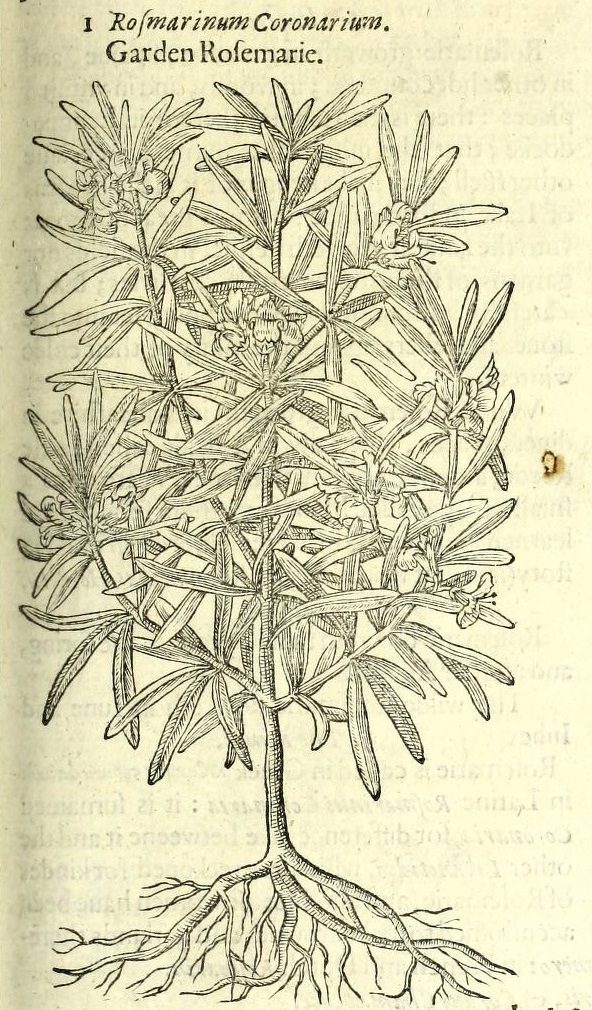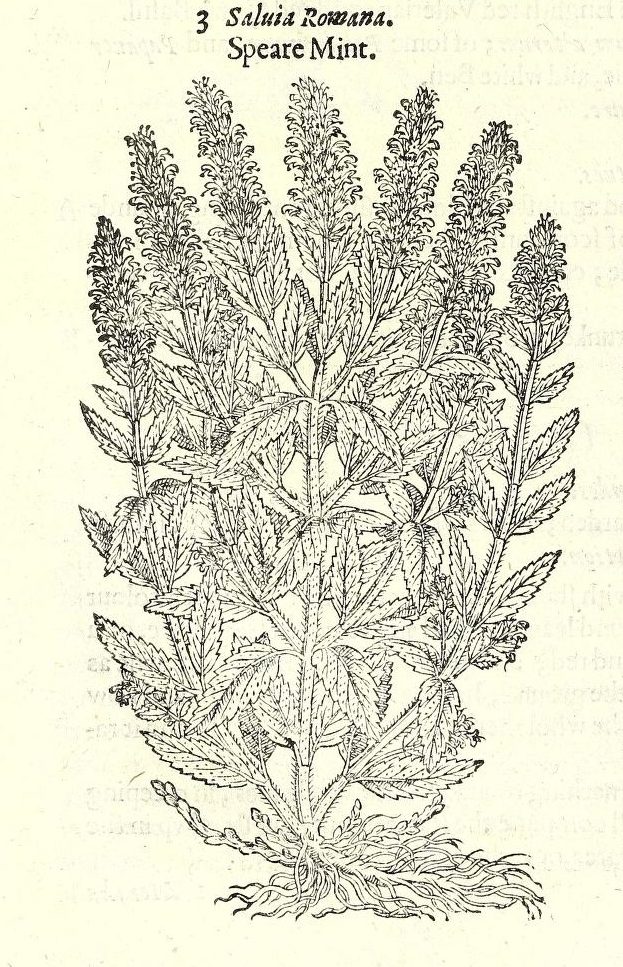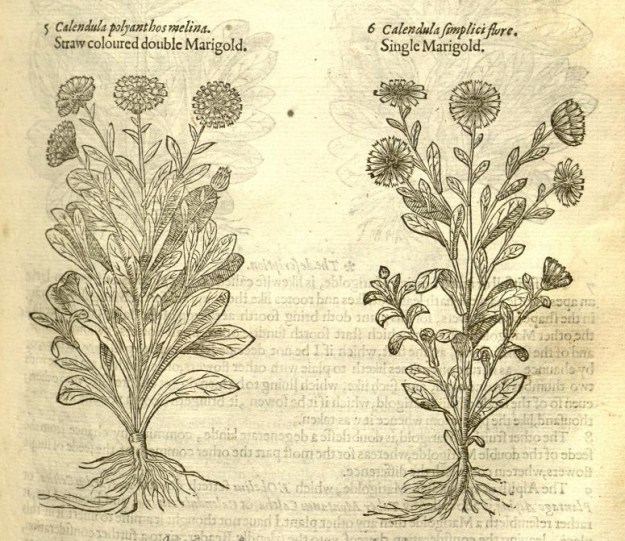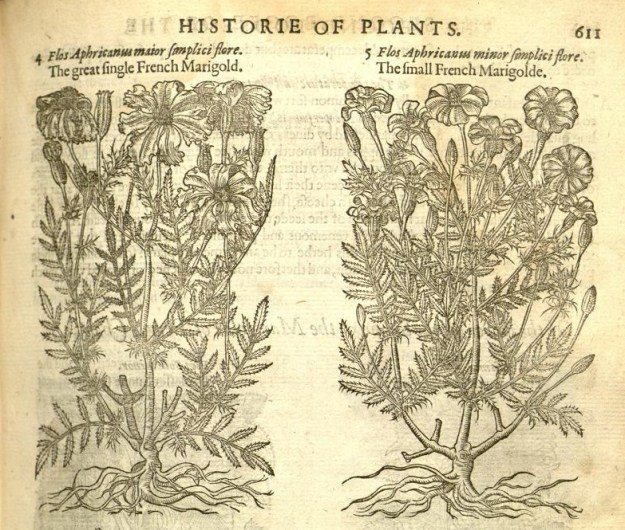
Garden rosemary from The herball or, Generall historie of plantes by John Gerard 1597. Images courtesy of The Getty Institute via archive.org
Here’s fine rosemary, sage and thyme.
Come buy my ground ivy.
Here’s fetherfew, gilliflowers and rue.
Come buy my knotted marjorum, ho!
Come buy my mint, my fine green mint.
Here’s fine lavender for your cloaths.
Here’s parsley and winter-savory,
And hearts-ease, which all do choose.
Here’s balm and hissop, and cinquefoil,
All fine herbs, it is well known.
Let none despise the merry, merry cries
Of famous London-town!
The Cries of London Anon. (17th century) from Poems on the Underground (Cassell,1997)
When traders’ cries like these were a familiar sound on London’s streets, herbal remedies were central to our treatment of disease. Ordinary plants like sage, thyme and ground ivy were grown in gardens, gathered from hedgerows or, as the poem demonstrates, sold door to door for domestic use as medicine.
The herball or, Generall historie of plants (1597) by John Gerard is a rich source of plant based cures and treatments considered effective against illness in the late sixteenth and early seventeenth centuries. It’s also a reminder of the important practical role gardens had in relation to our health in the past, and the ongoing quest for cures which continues to this day.
The herbs mentioned in the poem are listed here with woodcuts and excerpts from Gerard explaining some of their medicinal purposes. There’s a link below to the 1597 version of The Herball from The Getty Foundation.
 Of Sage.
Of Sage.
Gerard’s evocative description of the texture of sage leaves: ‘The great Sage is very full of stalks, fower square, of a woodie substance, parted into branches, about the which grow broad leaves, long, wrinckled, rough, whitish, very like to the leaves of a wilde Mullein, but rougher, and not so white, like in roughness to woollen cloth thread bare;’ He confirms that none of the sage varieties are native to England, but they are widely grown – ‘I have them all in my garden, most of them are very common.’

Of garden Time.
‘Time boiled in water and honie and drunken, is good against the cough and shortnesse of the breath.’ Dried thyme was used to make a medicine called Oximell, used as a cure for a range of ailments from intestinal worms to pains in the head and melancholy. ‘Made into powder and taken in the waight of three drams with Meade or honied vineger, called Oximell’

Of Ground Ivie, or Alehoofe.
‘Ground Ivie is commended against the humming noise and ringing sounde of the eares, being put into them, and for them that are hard of hearing.’ Gerard also recommends the leaves of ground ivy steeped in water for eye complaints – interestingly, not just for humans but for ‘horse, or cowe, or any other beast’.

Of Feverfew.
As Gerard observes, to grow well this plant requires sharp drainage: ‘The common single Feverfew groweth in hedges, gardens, and about olde walles. It joyeth to grow among rubbish.’ As its common name suggest, this herb is used to drive away ‘agues’ or fevers.

Of Wall flowers, or yellow stocke Gilloflowers.
‘These kindes of stocke Gilloflowers do grow in most gardens throughout England.’
‘.. yet are they not used in phisicke, except amongst certaine Empericks and Quacksalvers, about love and lust matters, which for modestie I omit.’
 Of Rue, or herbe Grace.
Of Rue, or herbe Grace.
‘Sage and with it herbe Grace or Rue,
Make drinks both safe and sound for you.’
Gerard records multiple uses for this herb, used both on its own or in combination with other ingredients. ‘Rue boiled with Dill, Fennell seede, and some Sugar, in sufficient quantitie of wine, swageth the torments and griping paines of the belly, the paines in the sides and breast, the difficultie of breathing, the cough, and stopping of the lungs, and helpeth such as are declining unto a dropsie.’

Of Marierome.
‘The leaves are excellent good to be put into all odoriferous ointments, waters, powders, broths, and meates.’ ‘There is an excellent oile to be drawen foorth of these herbes, good against the shrinking of sinewes, convulsions, and all aches proceeding of a cold cause.’

Of Mints.
Some uses of mint recorded by Gerard include stomach complaints and headaches: ‘Mint is marvellous wholsome for the stomack.’ ‘.. being applied to the forehead, or to the temples, as Plinie teacheth, doth take away the headache.’ Children’s ‘sore heads’ could also be treated with this herb.

Of Lavender spike.
Gerard records that lavender conserve was used for a variety of complaints affecting the head, including headaches, dizziness and fainting. Pill sized amounts of the conserve were to be taken daily: ‘Conserve made of the flowers with sugar, profiteth much against the diseases aforesaid, if the quantitie of a beane be taken thereof in the morning fasting.’

Of Parsley.
‘The leaves of garden Parsley are of a beautiful greene, consisting of many little ones fastened together, divided most commonly into three parts, and also snipt rounde about the edges:’ Parsley was believed to be a cure against venom and poisons, and could be effective for a cough if mixed or boiled with other medicines. Gerard observes that the roots of the plant were also used, ‘if they be boiled in broth; they be also delightfull to the taste, and agreeable to the stomack.’

Of Savorie.
Gerard describes winter savoury as ‘hot and drie in the third degree’ and having the same uses as thyme.

Of Harts ease, or Paunsies.
‘It is commended against inflammations of the lungs and chest, and against scabs and itchings of the whole body and healeth ulcers.’ Common names for the plant Gerard mentions include ‘Herbe Trinitie by means of the triple colour of the flowers’ and ‘three faces in a hood’.

Of Bawme.
‘Bawme drunke in wine, is good against the bitings of venemous beasts; comforteth the hart, and driveth away all melancholie and sadnesse’. Today we know this plant as lemon balm or Melissa officinalis.

Of Hyssope.
‘A decoction of Hyssope made with figs, water, honie, and rue, and drunken, helpeth the inflammation of the lungs, the olde cough, and shortnes of breath, and the obstructions or stoppings of the breast.’

Of Cinkefoile, or Five Finger Grasse.
‘The juice of the rootes while they be yoong and tender, is given to be drunken against the diseases of the liver and lungs, and all poison. The same drunk in meade or honied water, or wine wherein some pepper hath beene mingled, cureth the tertain and quartaine fevers:’
Further reading:























